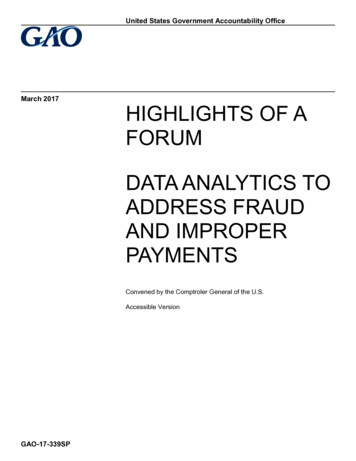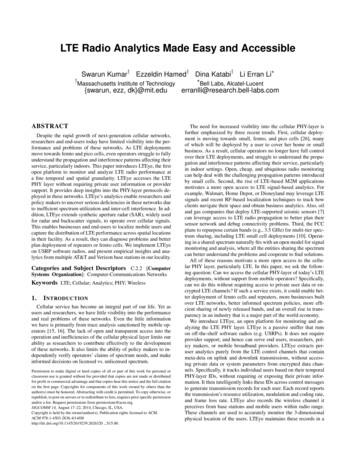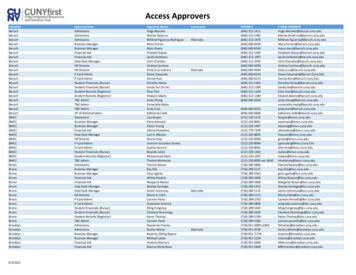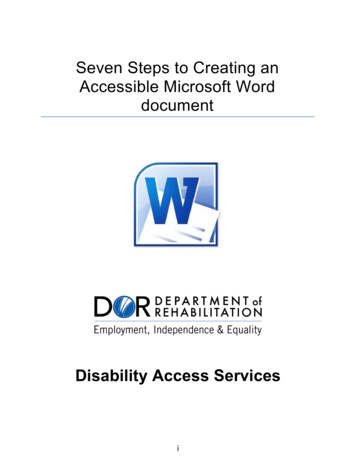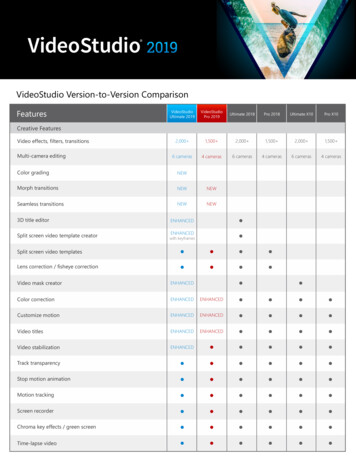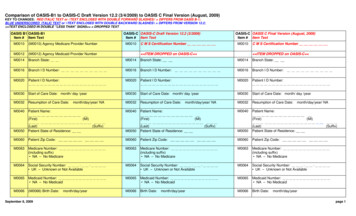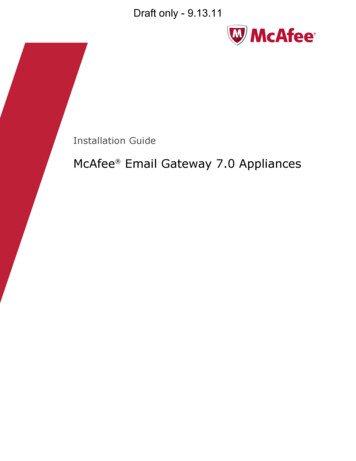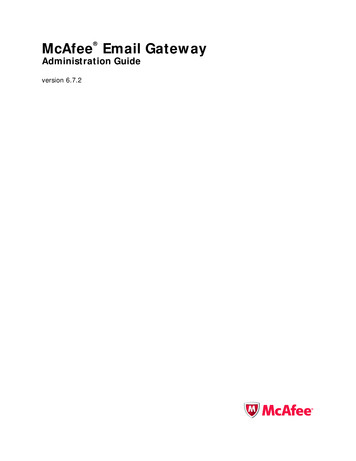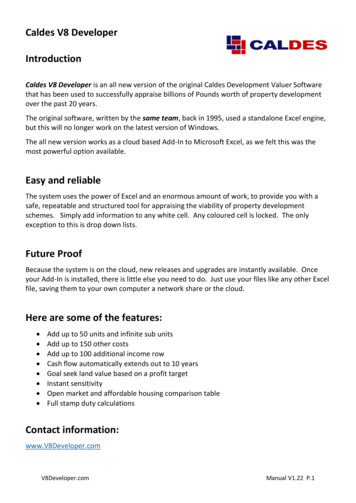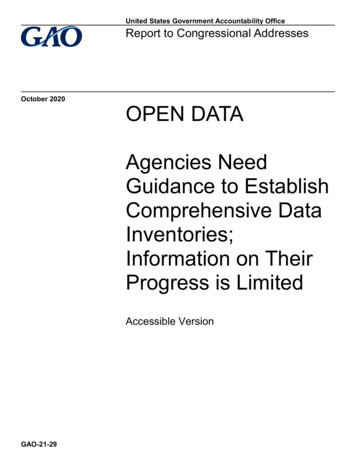
Transcription
United States Government Accountability OfficeReport to Congressional AddressesOctober 2020OPEN DATAAgencies NeedGuidance to EstablishComprehensive DataInventories;Information on TheirProgress is LimitedAccessible VersionGAO-21-29
October 2020OPEN DATAHighlights of GAO-GAO-21-29, a report tocongressional addresseesAgencies Need Guidance to EstablishComprehensive Data Inventories; Information onTheir Progress is LimitedWhy GAO Did This StudyWhat GAO FoundFederal agencies create and collectlarge amounts of data in support offulfilling their missions. Public accessto open data—data that are free touse, modify, and share—holds greatpromise for promoting governmenttransparency and engendering publictrust. Access to open data isparticularly important in the currentpandemic environment as governmentagencies, scientists, and the publicwork to understand and respond toCOVID-19 using data-focusedapproaches.The Open, Public, Electronic and Necessary Government Data Act of 2018(OPEN Government Data Act) codifies and expands open data policy andgenerally requires agencies to publish information as open data by default, aswell as develop and maintain comprehensive data inventories.The OPEN Government Data Actincludes a provision for GAO to reporton federal agencies’ comprehensivedata inventories. This report examinesthe extent to which 1) OMB, GSA, andNARA met their statutory requirementsto facilitate the establishment of federalagencies’ comprehensive datainventories; and 2) CFO Act agenciesdeveloped data inventories inaccordance with OMB guidance.GAO reviewed agencies’ websites andrelated documentation, andinterviewed OMB staff and GSA andNARA officials.The Office of Management and Budget (OMB) has not issued statutorily-requiredguidance for agencies to implement comprehensive data inventories, which couldlimit agencies’ progress in implementing their requirements under the act. OMBalso has not met requirements to publicly report on agencies’ performance andcompliance with the act. Access to this information could inform Congress andthe public about agencies’ open data progress and statutory compliance.Implementation Status of Selected OPEN Government Data Act RequirementsAssessmentFederal data catalogue: By July 2019, the General Services Administration (GSA)must maintain a point of entry dedicated to sharing agency data assets with thepublic, known as the “Federal data catalogue”. The Office of Management andBudget (OMB) and GSA must ensure agencies can publish data assets or links onthe website.Requirementfully metOnline repository: By July 2019, OMB, GSA, and the National Archives andRecords Administration (NARA) must collaborate to develop and maintain an onlinerepository of tools, best practices, and schema standards to facilitate the adoptionof open data practices across the federal government.Requirementfully metImplementation guidance: By July 2019, OMB must issue guidance for agenciesto implement comprehensive inventories.Requirementnot metBiennial report: By January 2020, and biennially thereafter, OMB mustelectronically publish a report on agency performance and compliance with this act.Requirementnot metSource: GAO analysis of Pub. L. No. 115-435, 132 Stat. 5529(Jan. 14, 2019), resources.data.gov, www.data.gov,What GAO Recommendsand an interview with OMB staff. GAO-21-29.GAO is making two recommendationsto OMB to issue requiredimplementation guidance and report onagency performance. GAO alsorecommends that OMB and GSAestablish policy to ensure the routineidentification and correction of errors inagency data. GSA concurred withGAO’s recommendation and OMB didnot comment on the report.GAO found that all 24 Chief Financial Officers (CFO) Act agencies display theirdata inventories on their websites, as well as on an online catalogue of federaldata assets. Agencies took a variety of approaches to providing public access toindividual data assets such as using Data.gov as the human-readable publicinterface, hosting searchable inventories on their own agency websites andproviding lists of data or downloadable files on their websites.View GAO-GAO-21-29. For moreinformation, contact Michelle Sager at202-512-6806 or SagerM@gao.gov.Information on the extent to which agencies regularly update their datainventories is limited. OMB and GSA do not have a policy to ensure the routineidentification and correction of errors in electronically published information. Theabsence of such a policy limits publicly available information on agency progress.As of September 2020, seven of the 24 CFO Act agencies had also publiclyreleased COVID-19 related datasets or linked to related information from theiropen data web pages as required by the Federal Data Strategy. These datasetsprovide data on a range of COVID-19 related topics including data on diseasetransmission and loans provided to businesses.United States Government Accountability Office
ContentsBackgroundOMB Met Some of Its Statutory Requirements, but Has Not IssuedImplementation Guidance Nor Reported on Agency ProgressCFO Act Agencies Published Open Data Inventories, but DataQuality Limitations Hinder the Ability to Track Agency ProgressConclusionsRecommendations For Executive ActionAgency Comments5816222324Appendix I: Objectives, Scope, And Methodology25Appendix II: Comments from General Services Administration29Appendix III: Comments from National Archives and Records Administration31Appendix IV: GAO Contacts and Staff Acknowledgements33GAO ContactStaff Acknowledgement3333Table 1: Implementation of OPEN Government Data ActRequirements Related to Comprehensive DataInventories10TableFiguresFigure 1: Timeline for Open Data Related Statutes and GuidanceFigure 2: OPEN Data Resources Page on Skills DevelopmentFigure 3: Example of Human Readable Public Interface onData.govFigure 4: Example of Searchable Data Catalogue on AgencyWebsiteFigure 5: Example of Non-Searchable List of Datasets on AgencyWebsitePage i713171819GAO-21-29 OPEN Data Act
AbbreviationsCAPCFOCOVID-19DATA ActFFATAGSAM-13-13NARAOGISOMBOPEN GovernmentData ActThe Commission2020 Action PlanCross-Agency PriorityChief Financial OfficerCoronavirus Disease 2019Digital Accountability and Transparency Act of 2014Federal Funding Accountability and TransparencyAct of 2006General Services AdministrationOpen Data Policy—Managing Information as anAsset MemorandumNational Archives and Records AdministrationOffice of Government Information ServicesOffice of Management and BudgetThe Open, Public, Electronic and NecessaryGovernment Data Act of 2018The Commission on Evidence-Based PolicymakingFederal Data Strategy 2020 Action PlanThis is a work of the U.S. government and is not subject to copyright protection in theUnited States. The published product may be reproduced and distributed in its entiretywithout further permission from GAO. However, because this work may containcopyrighted images or other material, permission from the copyright holder may benecessary if you wish to reproduce this material separately.Page iiGAO-21-29 OPEN Data Act
441 G St. N.W.Washington, DC 20548October 8, 2020The Honorable Ron JohnsonChairmanThe Honorable Gary PetersRanking MemberCommittee on Homeland Security and Governmental AffairsUnited States SenateThe Honorable Carolyn MaloneyChairwomanThe Honorable James ComerRanking MemberHouse Committee on Oversight and ReformFederal agencies create and collect considerable amounts of informationin support of fulfilling their missions. Open data—public access to federaldata that are free to use, modify, and share—hold great promise forpromoting government transparency, engendering public trust ingovernment, and stimulating entrepreneurship, innovation, and economicactivity.Open access to the large stores of government data is particularlyimportant in the current pandemic environment as government agencies,scientists, and the public work to understand and respond to theCoronavirus Disease 2019 (COVID-19) using data-focused approaches.Managing government information as an asset could also createefficiencies for federal agencies that support mission needs, improveservices and increase public access to information.1Recognizing the need to make federal government data accessible andusable for the public, Congress passed and the President signed theFoundations for Evidence-Based Policymaking Act of 2018 (EvidenceAct).2 Title II of the Evidence Act—the Open, Public, Electronic andNecessary Government Data Act of 2018 (OPEN Government DataAct)—requires federal agencies to publish their information as open data1Officeof Management and Budget, Open Data Policy—Managing Information as anAsset, OMB Memorandum M-13-13 (Washington, D.C.: 2013).2Pub.L. No. 115-435, 132 Stat. 5529 (Jan. 14, 2019).Page 1GAO-21-29 OPEN Data Act
Appendix I: Objectives, Scope, AndMethodologyusing standardized, nonproprietary formats, making data available to thepublic open by default, unless otherwise exempt.3 The act codifies andexpands on existing federal open data policy including the Office ofManagement and Budget’s (OMB) memorandum M-13-13 (M-13-13),Open Data Policy—Managing Information as an Asset.The OPEN Government Data Act requires that agencies develop andmaintain comprehensive data inventories and collaborate with nongovernmental entities, such as stakeholders, researchers, and the public,to understand how users value and use government data.4 The act alsoincludes requirements related to agency strategic planning efforts,including a requirement that each agency have an open data plan thatprioritizes data sets for disclosure on the Federal Data Catalogue.5In addition to these agency requirements, the OPEN Government DataAct directs OMB to facilitate agency implementation by issuing guidanceand reporting on agencies’ progress in meeting their open data statutoryrequirements. OMB must also collaborate with the General ServicesAdministration (GSA) to maintain a federal data catalogue of agencyinventories and collaborate with GSA and the National Archives and344U.S.C. § 3506(b)(6) as amended by OPEN Government Data Act, § 202(c)(1)(A)(iv).Throughout this report we refer to Title II of the Evidence Act —the Open, Public,Electronic and Necessary Government Data Act of 2018—as the OPEN Government DataAct. Under the OPEN Government Data Act, the term “agency” means any executivedepartment, military department, government corporation, government controlledcorporation, or other establishment in the executive branch of the government (includingthe Executive Office of the President), or any independent regulatory agency, but does notinclude— (1) ourselves; (2) the Federal Election Commission; (3) the governments of theDistrict of Columbia and of the territories and possessions of the United States, and theirvarious subdivisions; or (4) government-owned contractor-operated facilities, includinglaboratories engaged in national defense research and production activities. 44 U.S.C. §3502.444U.S.C. § 3506(b)(2)(B)(i)(II) as amended by OPEN Government Data Act, §202(c)(1)(A)(i). The term “data” means recorded information, regardless of form or themedia on which the data are recorded.544U.S.C. § 3506(b)(2)(B)(iv) as amended by OPEN Government Data Act, §202(c)(1)(A)(i). The priority data sets are also evaluated for a determination under 5U.S.C. § 552.Page 2GAO-21-29 OPEN Data Act
Appendix I: Objectives, Scope, AndMethodologyRecords Administration (NARA) to develop a repository of tools andresources to support agencies’ open data efforts.6The OPEN Government Data Act includes a provision for us to report onfederal agencies’ comprehensive data inventories, among otherrequirements.7 This report is in partial response to that provision.Specifically, this report examines the extent to which (1) OMB, GSA, andNARA met their statutory requirements under the act to facilitate theestablishment of federal agencies’ comprehensive data inventories; and(2) Chief Financial Officers (CFO) Act agencies developed datainventories in accordance with OMB guidance.8 Consistent with ourmandate under the act, we plan to issue a subsequent report thatexamines the value and completeness of the agency open datainventories.To assess the extent to which OMB, GSA, and NARA met their statutoryrequirements we reviewed the OPEN Government Data Act to determinethe legal requirements for establishing and maintaining comprehensivedata inventories. We compared these requirements to OMB guidance tosee if OMB guidance complied with the requirements.9 We also reviewedwebsites developed and maintained in fulfillment of OMB guidance orstatutory requirements for a central data catalogue and online644U.S.C. § 3511(c)(1), (2) as amended by OPEN Government Data Act, § 202(d)(1).Specifically, the Director of OMB is required to collaborate with the Office of GovernmentInformation Services, a component of NARA, and the Administrator of General Services,the head of GSA.7OPENGovernment Data Act, § 202(g)(1).8TheCFO Act, among other things, established the position of agency Chief FinancialOfficer in the following 24 agencies, known as the CFO Act agencies: Departments ofAgriculture, Commerce, Defense, Education, Energy, Health and Human Services,Homeland Security, Housing and Urban Development, Interior, Justice, Labor, State,Transportation, Treasury, Veterans Affairs, National Aeronautics and SpaceAdministration, Environmental Protection Agency, Agency for International Development,GSA, National Science Foundation, Nuclear Regulatory Commission, Office of PersonnelManagement, Small Business Administration, and Social Security Administration. 31U.S.C. § 901(b).9Officeof Management and Budget, Open Data Policy—Managing Information as anAsset; and Office of Management and Budget, Phase 1 Implementation of theFoundations for Evidence-Based Policymaking Act of 2018: Learning Agendas,Personnel, and Planning Guidance, OMB Memorandum M-19-23 (Washington,D.C.:2019).Page 3GAO-21-29 OPEN Data Act
Appendix I: Objectives, Scope, AndMethodologyrepository.10 We interviewed officials and staff from OMB, GSA and NARAwho were involved in administering and overseeing OPEN GovernmentData Act data inventory requirements.To identify the extent to which CFO Act agencies developed datainventories aligned with existing OMB guidance, we reviewed all 24 CFOAct agency websites. To identify whether CFO Act agencies’ open datainventories meet M-13-13 requirements, we reviewed inventory metricsavailable through GSA’s Agency Progress Dashboard.11 Metrics availablethrough the dashboard include information on the percentage of datasetsin each agency’s inventory with appropriate descriptive information andworking web links. We also interviewed agency officials about thedashboard’s intent and use.We also identified the extent to which agencies prioritized publishingCOVID-19 related datasets as directed by the Federal Data Strategy.OMB issued guidance in March 2020, which directed agencies toreprioritize work and leverage existing information to support COVID-19response efforts. Toward that end, the Federal Data StrategyDevelopment Team directed agencies to prioritize these datasets,consistent with OMB guidance. Accordingly, we identified COVID-19related datasets made available on Data.gov or on agency websites as ofSeptember 2020. Additional details on our objectives, scope, andmethodology can be found in appendix I.We conducted this performance audit from January 2020 to October 2020in accordance with generally accepted government auditing standards.Those standards require that we plan and perform the audit to obtainsufficient, appropriate evidence to provide a reasonable basis for ourfindings and conclusions based on our audit objectives. We believe that10Thecentral data catalogue is a public searchable consolidated resource of governmentdata, available at https://www.data.gov/ and hosted by GSA. The online repositoryprovides tools and resources to federal agencies to help them develop and maintain theiropen data inventories, available at https://resources.data.gov/.11GSAtracks several automated metrics regarding the content of agency data inventorieson the Project Open Data Dashboard (referred to in this report as Agency ProgressDashboard), located at: https://labs.data.gov/dashboard For example, these metricsinclude number of public datasets, percentage of datasets with working links to data, andpercentage of datasets that include all required descriptive information. Due toinconsistencies in this dashboard, we reviewed four quarterly reports (May 2019-March2020) to determine whether each CFO Act agency appeared at least once. If an agencyappeared at least once during the four reports, we considered it to meet M-13-13’sstandard that inventories can be aggregated by Data.gov.Page 4GAO-21-29 OPEN Data Act
Appendix I: Objectives, Scope, AndMethodologythe evidence obtained provides a reasonable basis for our findings andconclusions based on our audit objectives.BackgroundGovernment wide Open Data InitiativesThe OPEN Government Data Act is one of several government-wideinitiatives focused on improving the public’s access to governmentinformation.12 For example, during the past 14 years, Congress and theadministration have taken several steps to improve the availability,transparency, and quality of federal data:·In 2006, Congress passed and the President, signed the FederalFunding Accountability and Transparency Act (FFATA). This actrequires agencies to report information on federal awards to thepublic—such as contracts, grants, and loans.13·In 2013, OMB issued M-13-13. The memorandum directed executivedepartments and agencies to make new government informationaccessible to the public in open formats, standardize data formats andlocations to access information, and institute strategic planning andprivacy protections for open data.14·In 2014, Congress passed and the President signed, the DigitalAccountability and Transparency Act (DATA Act). The DATA Actexpanded FFATA to include direct federal agency expenditures andlink contract, loan, and grant spending information to federal programsso that taxpayers and policy makers can more effectively track federalspending.1512Pub.L. No. 115-435, 132 Stat. 5529, 5534 (Jan. 14, 2019).13Pub.L. No. 109-282, 120 Stat. 1186 (Sept. 26, 2006), codified at 31 U.S.C. § 6101 note.14Officeof Management and Budget, M-13-13 Open Data Policy--Managing Informationas an Asset.15Pub.Page 5L. No. 113-101, 128 Stat. 1146 (May 9, 2014).GAO-21-29 OPEN Data Act
Appendix I: Objectives, Scope, AndMethodology·In 2016, Congress established the Commission on Evidence-BasedPolicymaking (the Commission) to study the availability and use ofevidence, such as data, in government.16 The Commission’s 2017report states that multiple entities within the federal government (suchas components, agencies, or offices) are responsible for generatingdifferent sources of evidence. However, the Commission noted thatagencies’ capabilities to generate a full range of evidence varied andtheir efforts were poorly coordinated.17·In 2019, Congress passed, and the President signed, the OPENGovernment Data Act. It requires federal agencies to publish recordedinformation as open data using standardized, non-proprietary formats,making data available to the public open by default unless otherwiseexempt.18·In 2020, the Federal Data Strategy team issued a 2020 Action Plan(2020 Action Plan) to guide agencies’ initial efforts to establishprocesses, build capacity, and align existing work on strategic use ofdata.19 The Federal Data Strategy supports the Leveraging Data as aStrategic Asset Cross-Agency Priority (CAP) Goal. This CAP Goalfocuses on enabling public use of and access to data and improvinguse of data for government decision-making and accountability.20·The May 2020 update to the Federal Data Strategy 2020 ActionPlan directed agencies to prioritize adding COVID-19 responserelated data assets to their comprehensive
Figure 1: Timeline for Open Data Related Statutes and Guidance 7 Figure 2: OPEN Data Resources Page on Skills Development 13 Figure 3: Example of Human Readable Public Interface on Data.gov 17 Figure 4: Example of Searchable Data Catalogue on Agency Website 18 Figure 5: Example of Non-Searchable List of Datasets on Agency Website 19
